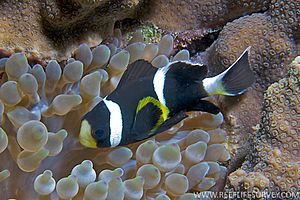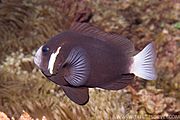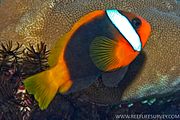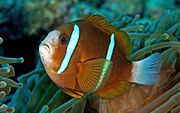Whitesnout anemonefish facts for kids
Quick facts for kids Whitesnout anemonefish |
|
|---|---|
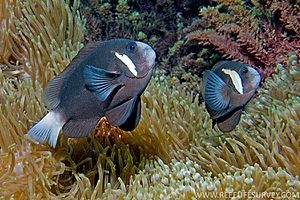 |
|
| Scientific classification |
The Whitesnout Anemonefish, also known as McCulloch's Anemonefish, is a type of anemonefish. You can find it in warm waters around Lord Howe Island and Norfolk Island. This fish was named after Allan Riverstone McCulloch, who used to be in charge of fish at the Australian Museum in Sydney.
Like all anemonefish, the Whitesnout Anemonefish lives in a special partnership with sea anemones. This partnership is called a symbiotic mutualism, which means both the fish and the anemone help each other. The anemone's stinging tentacles don't bother the fish at all!
These fish have a unique way of changing gender. They are sequential hermaphrodites, meaning they can change from male to female. The biggest fish in the group is always the female leader. The second biggest is the breeding male. The other males are smaller and don't breed. If the female leader dies, the breeding male changes into a female. Then, the largest non-breeding male becomes the new breeding male.
Contents
About the Whitesnout Anemonefish
The Whitesnout Anemonefish is mostly dark brown. It has a light-colored snout and a white bar on each side of its head. Its tail is also light in color. These white bars do not connect over the top of its head. Young Whitesnout Anemonefish have two white bars. The edges of their pectoral fins (the fins on their sides) are yellow. These fish can grow up to about 12 centimeters (about 4.7 inches) long.
How to tell them apart
The Whitesnout Anemonefish looks a bit like another fish called A. melanopus, or the Red & Black Anemonefish. But you can tell them apart! The Red & Black Anemonefish has a reddish chest, belly, and top fin. Its tail is yellowish or slightly red. Also, its white bars connect over the top of its head, which is different from the Whitesnout Anemonefish.
Scientists have studied the genes of these fish. They found that the Whitesnout Anemonefish is related to A. akindynos, also known as the Barrier Reef Anemonefish. This means they share some family history!
Where they live and their home
The Whitesnout Anemonefish lives only in a few places in the southwestern Pacific Ocean. You can find them around Lord Howe Island, Middleton Reef, Elizabeth Reef, and Norfolk Island.
Their special anemone home
Anemonefish don't just pick any sea anemone to live in. They are very picky! The Whitesnout Anemonefish is super specialized. It lives with only one type of anemone:
- Entacmaea quadricolor (the Bubble-tip anemone)
Protecting the Whitesnout Anemonefish
Anemonefish and their anemone homes live on coral reefs. These reefs are facing many environmental problems. Just like corals, anemones have tiny living things inside them called zooxanthellae. These tiny helpers can leave the anemone if the water gets too warm or too acidic. This is called bleaching, and it can harm the anemone.
The Whitesnout Anemonefish is special because it lives in a very small area. It also only lives with one type of anemone. These things make it more likely to be at risk of disappearing. Because of this, scientists are concerned about protecting this species.
Why the name?
The name mccullochi was given to honor Allan Riverstone McCulloch. He was an Australian scientist who studied fish. He was the one who first collected the example specimen of this fish.
In fish tanks
It is possible to breed the Whitesnout Anemonefish in captivity, meaning in aquariums.
- Amphiprion mccullochi. Whitely, 1929. Retrieved through: World Register of Marine Species.


